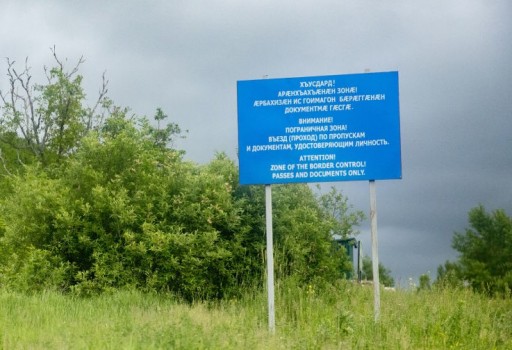-
Key Persons
-
Important Agreements
-
Chronology of Events
-
 Infographics
Infographics
-
Key Agencies
-
Chronology of Visits
-
 News
News
-
 Monthly Review
Monthly Review
"Borderization" in the Tskhinvali Region: Review of 2021

Author: Elene Mindiashvili
In 2021, a total of 20 cases of “borderization” were reported in five municipalities of Georgia, nine of them - in Gori municipality.
Last year, the following villages were hotspots in terms of “borderization:”
- Kareli municipality: Villages of Ghogheti, Takhtisdziri, Dvani, Atotsi
- Gori municipality: Villages of Khurvaleti, Bershueti, Kirbali
- Kaspi municipality: Village of Goraka
- Dusheti municipality: Village of Gremiskhevi
- Khashuri municipality: Village of Chorchana
The months of April, May, August, September, and December were distinguished by the “borderization” intensity. Most cases were reported in December.
Observing the precedents clearly reveals tactics which are built on the narrative of “invisibility” of the occupation regime, meaning that a special feature of the dynamics of “borderization” is to manage the process with as little attention as possible. Two tactics are used to achieve this: first is to establish the so-called “fear zones” which, in turn, are closely linked to illegal detentions. In places where it is impossible to create “fear zones” due to constant patrols (Chorchana) and/or permanent residents (Khurvaleti), the occupation forces resort to a second tactics – “borderization” works at night.
Both tactics are timed, which means that it takes several weeks, often several months, to complete the full cycle of moving the occupation line to Georgian-controlled territory. As a result of observing the process, the whole cycle of “borderization” can be divided into several stages. The first stage is demarcation work. At this stage, the trajectory of a “new” occupation line is defined. The demarcation process takes place in different ways: if there are no trees or shrubs in the area, wooden, painted poles are used for the demarcation process, and if the place is forested or shrubby, the plants are marked directly with colored paints or fabrics.
The second stage is establishing a “new” occupation line which usually has different faces depending on the terrain. In the plain area, the process is manifested by digging up fire ditches, and in the highlands and forests - by linear deforestation. The next stage is to install supporting poles, and finally - the metal construction, which in some cases is represented by a barbed wire, and in some – by a metal capital, often green fence. Finally, a banner marking the “border” is installed.
“Fear Zones”
Creating “fear zones” is part of a relatively deeper and more planned strategy. The “fear zone” is an area controlled by the central government of Georgia directly adjacent to the occupation line, where the occupation forces illegally patrol. Given the peculiarities of rural distribution, the occupation line, in most cases, is bordered by arable land, orchards, pastures, forests or cemeteries. Since these areas are not permanent residences and the population only moves for their intended purpose - seasonally, several times a week or a day only for a certain period of time, it facilitates constant patrolling and control for the occupation regime. In addition, the most cases of illegal detention occur in these “fear zones.” According to the locals, the so-called border guards often cross into Georgian-controlled territory and illegally detain locals nearby. In other words, movement along the occupation line and often even a few hundred meters away from it, poses the risk of illegal detention to the citizens of Georgia. Consequently, the locals avoid approaching these areas and as a result the area is gradually cleared for a new wave of “borderization.”
“Borderization” Facts
21 April
The occupation forces resumed the demarcation process by installing wooden poles near the villages of Takhtisdziri and Dvani, Gori municipality, and marked the pasture area which people from both villagers used daily. On April 23, fire ditches were dug up on the same perimeter and metal poles were delivered. On September 11, works were resumed on the territory of Takhtisdziri-Dvani – new occupation line illegally appropriated 20 hectares of land. The locals lost their arable lands and pastures.
April 25
Representatives of the occupation regime appeared on a section of the villages of Tamarasheni-Ghogheti, Kareli municipality, and installed demarcation wooden painted poles. At the same time, ditches were dug up. The demarcation process continued on May 6 – digging up of fire ditches and the installation of poles were resumed along the full perimeter.
7 May
Representatives of the occupation forces resumed the so-called “borderization” works in the village of Khurvaleti, Gori municipality. The works were carried out in a few tens of meters near the settlement. According to locals, the occupation forces laid barbed wire on the already installed poles.
10 May
The process of “borderization” was started near the village of Goraka, Karspi municipality. In particular, the occupation forces cut down the forest in a straight line and marked trees. Another wave of “borderization” in Goraka occurred on December 24, when the linear cutting of Goraka-Skhvilo forest was resumed.
5 July
The occupation forces resumed the process of “borderization” in the village of Atotsi, Kareli municipality. They laid barbed wire on the previously inserted poles, at about 50 meters length.
June-August
The occupation forces installed a new fence on the territory of the village Bershueti, Gori municipality. According to Davit Katsarava, a member of the anti-occupation movement – Power is in Unity, a new fence on the territory adjacent to Bershueti was discovered during the August 16 patrolling, while this fence was not observed during the June 13 patrolling.
16 August
In the village of Khurvaleti, Gori municipality, the occupation forces elevated barbed wire using iron poles stolen from Data Vanishvili's house which fell under the occupied territory.
22 August
Activities of Russian so-called border guards were observed near the village of Khurvaleti, Gori municipality. A new banner marking the so-called border was installed along the occupation line.
3 September
The occupation forces laid a new barbed wire fence and installed the so-called border banner in the village of Khurvaleti, Gori municipality. The new banner blocked the inner road of the village and cut off Nora Batonisashvili, a resident of Khurvaleti, an access road to her house and land. According to Batonisashvili, representatives of the occupation regime have established informal control over this area since April 2019. Initially, she stopped cultivating the land, then stopped visiting, and now a barbed wire fence appeared next to her house.
4 September
The occupation forces erected another banner on the territory of the village of Khurvaleti, Gori municipality. The banner was discovered by the anti-occupation movement - Power is in Unity. This banner is about one kilometer away from the central highway and differs from the previously installed banners. The banner in the field reads: “Attention! Dangerous section!”
October 13-18
Representatives of the occupation regime dug up new fire ditches in the village of Atotsi, Kareli municipality, reported the leader of the anti-occupation movement, Davit Katsarava.
14 November
The leader of the anti-occupation movement - Power is in Unity, Davit Katsarava, spread an information that as a result of the November 14 patrol in the village of Kirbali, Gori municipality, a new checkpoint was discovered which, presumably, was built in the last week. He said that the checkpoint is much larger than a standard one.
25 November
In the village of Khurvaleti, Gori municipality, representatives of the occupation forces dug up ditches and started the installation of fences. The abovementioned works were actively performed at night, at a time less noticeable to the population. As of today, the fencing works on the full section have not been completed.
6-11 December
Davit Katsarava, the leader of the anti-occupation movement - Power is in Unity, spread information in connection with the ongoing fencing works on a section of the villages of Chorchana-Jria, Khashuri municipality, officially Georgian-controlled territory. According to him, the first wave of “borderization” took place at the end of October this year, and the process continued about a month later, on December 6-11.
19 December
The infrastructural development of a military base bordering the village of Gremiskhevi, Dusheti municipality, became particularly noticeable at the end of December. New trench-type ditches appeared on the Gremiskhevi ridge.
25 December
According to Davit Katsarava, the leader of the anti-occupation movement - Power is in Unity, representatives of the occupation forces installed a motion detector in the village of Khurvaleti, Gori municipality, at the barbed wire fence near the house of Data and Valia Vanishvilis, from where food and other necessities were usually delivered to Valia Vanishvili from the territory controlled by the Georgian government.

